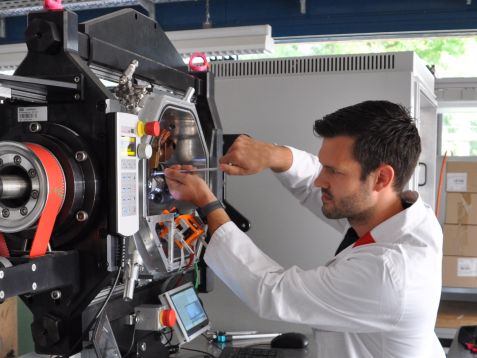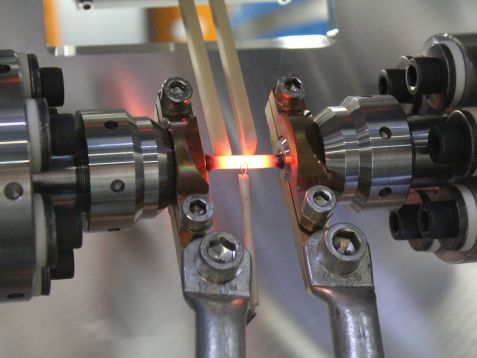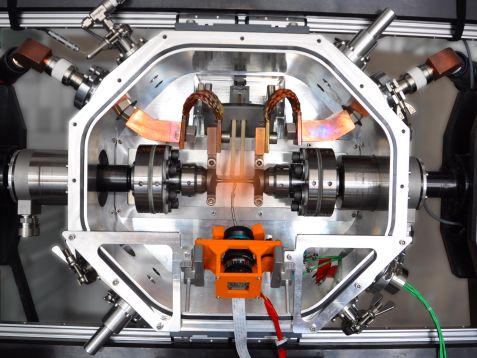MLZ is a cooperation between:
 > Technische Universität München
> Technische Universität München > Helmholtz-Zentrum Hereon
> Helmholtz-Zentrum Hereon
 > Forschungszentrum Jülich
> Forschungszentrum Jülich
MLZ is a member of:
 > LENS
> LENS > ERF-AISBL
> ERF-AISBL
MLZ on social media:

MLZ (eng)
Lichtenbergstr.1
85748 Garching
05.08.2021
Pressure and heat: Testing alloys for gas turbines
Gas turbines must endure extreme conditions like high forces at temperatures above 600°C. Gas turbine materials therefore must be sufficiently robust, and as such they are under constant development. Together with the Friedrich-Alexander-Universität Erlangen-Nürnberg (FAU), VDM Metals International GmbH tested its improved VDM Alloy 780 using a specially developed testing machine at the Research Neutron Source Heinz Maier-Leibnitz (FRM II).
The new nickel VDM Alloy 780 is resistant to high temperatures and corrosion, making it ideally suited for use in gas turbines. “It can manage temperatures 50 – 100 °C higher than conventional alloys, thus extending the range of applications”, adds Dr. Frank Kümmel from MLZ’s Advanced Materials Group. The nickel alloy is not the only innovation: the researchers have developed a testing apparatus specifically for investigating this alloy.
VDM Alloy 780 under pressure
Neutrons help in the study of the mechanical properties of VDM Alloy 780. The researchers mount the sample in the testing apparatus, which creates the desired environmental conditions and maintains or changes them throughout the investigation. While these extreme forces are applied to the sample, the scientists study the changes in the alloy using neutrons on the STRESS-SPEC instrument. Before and after loading, the sample can additionally be checked for pores and cracks at the ANTARES. The SANS-1 instrument then illuminates nanoscale structures. The findings from these experiments help the scientists understand the properties of the alloy: they provide information on how the alloy is structured and what influence high temperatures and forces have on the alloy. VDM Metals International GmbH, with their headquarters in Germany, thus knows how to adapt the manufacturing process to further optimize the alloy.
1200°C in the testing apparatus
To replicate the extreme conditions of a gas turbine, a special sample environment is necessary. The new testing machinery generates temperatures of up to 1200°C, and recreates a vacuum or an air environment similar to a gas turbine. During the investigations, the testing system also generates forces such as tension or compression on the sample, simulating the large centrifugal forces of a gas turbine in operation.
“With our tests, we wanted to investigate two questions: Does our testing machine work as it should? And what are the mechanical properties of the new VDM Alloy 780?” Frank Kümmel explains.
The initial results make the researchers happy: the testing apparatus meets all expectations and works perfectly. The contact free temperature measurement developed by working student Osama Deeb also performs well. The researchers are still automating the operation of the machine so that visiting scientists can also use it easily.
Special synergies
In addition to VDM Metals International GmbH, everyone involved benefits from this research. According to Frank Kümmel, the entire project called HiMat, funded by the German Federal Ministry of Education and Research (BMBF), is a fruitful team effort: “The good interaction of the three cooperation partners has been very successful: the MLZ as a large-scale research facility with the FRM II neutron source and the FAU Erlangen with its special knowledge in microstructures and methods that complement us, and finally the industrial partner VDM Metals International GmbH, which is further developing the alloy.”
The successful collaboration is setting a new goal for themselves. They want to upgrade the testing apparatus so that it can generate even more complex test conditions, such as rapid sample cooling from high temperatures, cyclic loads, or other gas environments. So, in the future, extreme conditions even closer to those in the aircraft turbine will be manifested in the testing apparatus.
Original Publication:
F. Kümmel, A. Kirchmayer, C. Solís, M. Hofmann, S. Neumeier, R. Gilles, Deformation Mechanisms in Ni-Based Superalloys at Room and Elevated Temperatures Studied by In Situ Neutron Diffraction and Electron Microscopy, Metals (2021) 11, 719. DOI: doi.org/10.3390/met11050719
More Information:
The HiMat project was funded by the German Federal Ministry of Education and Research. Researchers from the company VDM Metals International GmbH, the Department of Materials Science of the Friedrich-Alexander-Universität Erlangen-Nürnberg (FAU) (Institute I: General Material Properties) and the Advanced Materials Group of the MLZ collaborated on the investigations.
The Research Neutron Source Heinz Maier-Leibnitz (FRM II) provides neutrons and positrons for research, industry, and medicine. As a service facility for up to 1200 visiting scientists per year, the Heinz Maier-Leibnitz Zentrum (MLZ) at FRM II provides unique scientific instruments for neutron and positron research. The MLZ is a cooperation of the Technical University of Munich, the Research Center Jülich and the Helmholtz Zentrum Hereon. It is jointly funded by the German Federal Ministry of Education and Research, the Bavarian State Ministry of Science and the Arts, and partners of the cooperation.
Contact:
Ralph Gilles
Leitung Advanced Materials
Tel: 089 289 14665
E-Mail: ralph.gilles@frm2.tum.de
Frank Kümmel
Advanced Materials
Tel: 089 289 54827
E-Mail: frank.kuemmel@frm2.tum.de
MLZ is a cooperation between:
 > Technische Universität München
> Technische Universität München > Helmholtz-Zentrum Hereon
> Helmholtz-Zentrum Hereon
 > Forschungszentrum Jülich
> Forschungszentrum Jülich
MLZ is a member of:
 > LENS
> LENS > ERF-AISBL
> ERF-AISBL
MLZ on social media:





